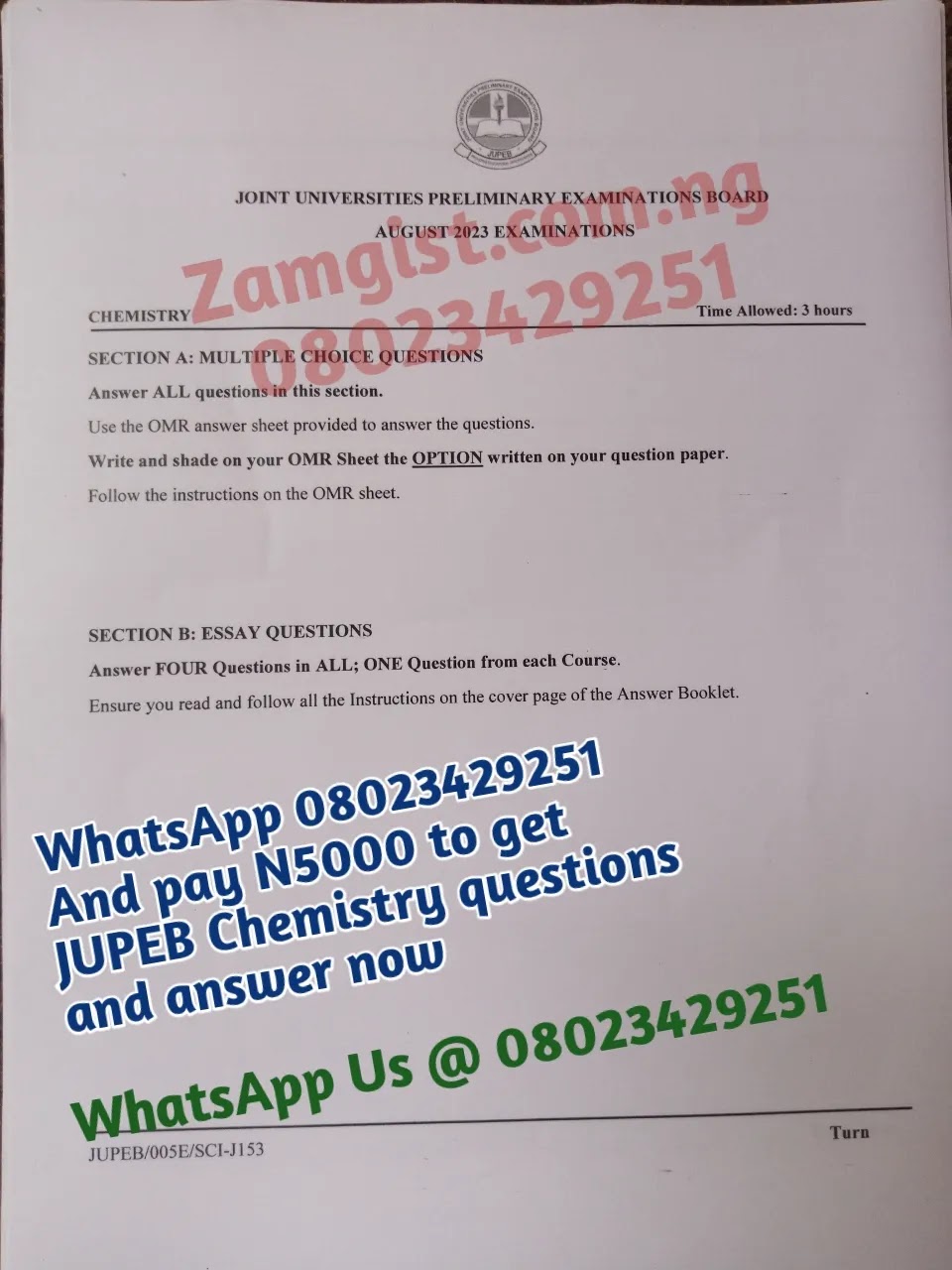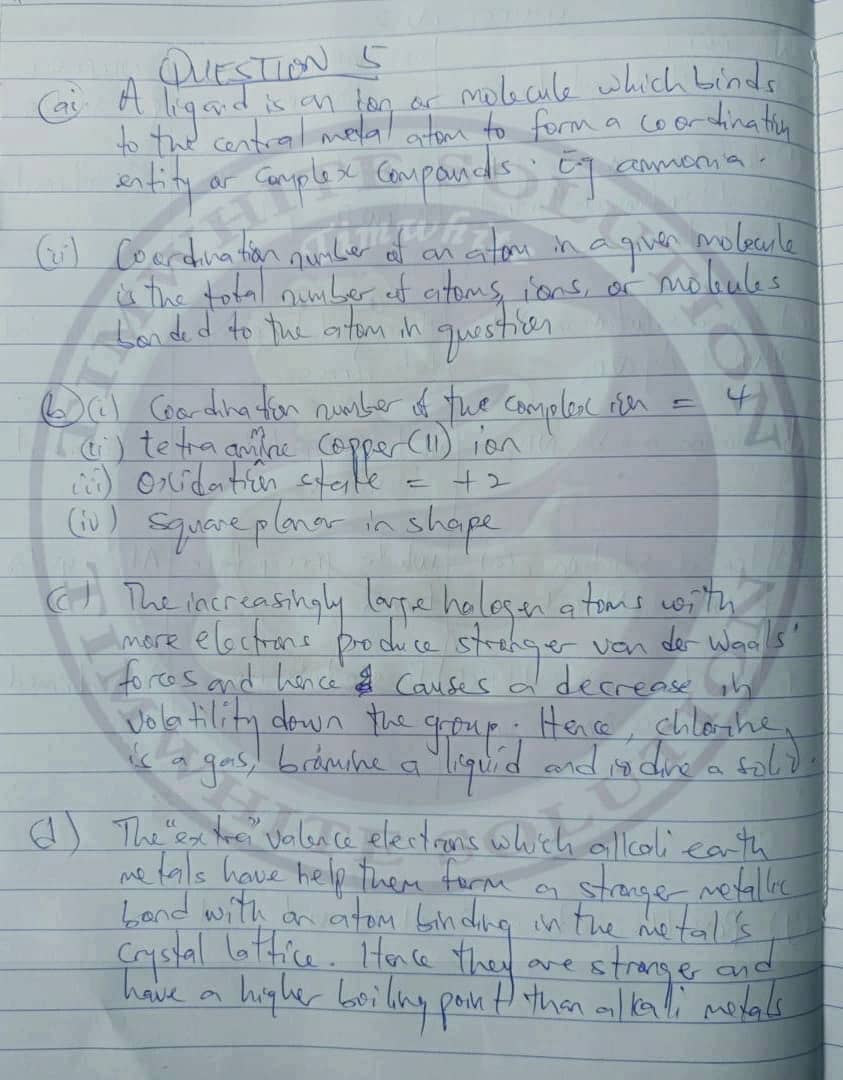Joint Universities Preliminary Examination Board (JUPEB) has scheduled JUPEB Chemistry Theory and Obj 2023 Questions And Answers to Kick off on Thursday 3rd – August – 2023.
JUPEB Chemistry Theory and Obj 2023 Questions And Answers
Here on zamgist, we have solved all the questions for JUPEB Chemistry Theory and Obj 2023 and its available now.

CLICK HERE TO CHAT ME UP ON WHATSAPP & GET IT NOW



| 2023 JUPEB EXPO | JUPEB Chemistry Theory and Obj 2023 Questions And Answers |
|---|---|
| N5000 Naira | |
| Online Password | N5000 Naira |
| Direct SMS | N/A |
| Delivery Time | Midnight or 4 hours before exam |
| Answer page | https://zamgist.com.ng/answer-page |
| WhatsApp No. | 08023429251 |
| Source | ZAMGIST |
| Group | ZAMGIST MIRACLE CENTER |
| WhatsApp Group Link | Click Here to Join |
| Tags | JUPEB Chemistry Theory and Obj 2023 Questions And Answers |
JUPEB Chemistry Theory and Obj Expo 2023
==> Online PIN: N5000
Online PIN MEANS The Pin to access our answers online via https://zamgist.com.ng/answer-page will be sent to u at least 4 hours before the exam to access our answers.
==> WhatsApp: N5000
Whatsapp MEANS The answer will be sent to you on WhatsApp after we confirm your subscription. Add Us In WhatsApp With 08023429251.
To Make Payment
Simply Transfer the exact amount mentioned above to the account below:
8023429251
Palmpay
Adewale kazeem
After Payment, Send The Following details:-
(i) Payment Receipt
(ii) Your Name
(iii) Subject
(iv) Phone number
===> 08023429251 via WhatsApp
JUPEB Chemistry Theory Answer 2023
Q1

===================================
Q3


===================================
Q5

===================================
Q7

===================================
Q8


===================================
JUPEB CHEMISTRY
NUMBER FIVE
(5a)
(i) A ligand is an atom ion or molecule that can donate a pair of electrons to form a chemical bond with a central metal atom or ion. It acts as a Lewis base or electron pair donor in a coordination compound.
(ii) Co-ordination number refers to the number of ligands that are bonded to a central metal atom or ion in a coordination compound. It represents the number of donor atoms surrounding the central atom. The coordination number gives information about the spatial arrangement or geometry of the compound.
(5b)
(i) The coordination number of the complex ion [Cu(NH₃)₄]²⁺ is 4. This is because there are 4 ammonia (NH₃) ligands attached to the central copper (Cu) ion.
(ii) The IUPAC name of the complex ion [Cu(NH₃)₄]²⁺ is tetraamminecopper(II) ion. This name indicates that there are four ammonia ligands attached to a copper ion with a +2 oxidation state.
(iii) The oxidation state of the central copper (Cu) ion is +2. This is because the complex ion has a net charge of +2 (the [Cu(NH₃)₄]²⁺ ion is positively charged) and each ammonia ligand has a neutral charge.
(iv) The shape of the complex ion [Cu(NH₃)₄]²⁺ is tetrahedral. This is because the four ammonia ligands are arranged around the central copper ion in a tetrahedral geometry with bond angles of approximately 109.5 degrees.
(5c)
(i) Iodine is a solid because it has a higher boiling point and a higher melting point compared to bromine and chlorine. The reason for this is the increasing strength of the van der Waals forces between the molecules as you go down Group 17.
(ii) Bromine is a liquid at room temperature because it has a lower boiling point and melting point compared to iodine and chlorine. Bromine molecules have weaker van der Waals forces compared to iodine making it easier to overcome these forces and transition from a solid to a liquid state.
(iii) Chlorine is a gas because it has the lowest boiling point and melting point among the three. The intermolecular forces in chlorine molecules are the weakest resulting in a lower boiling and melting point. This weak force allows the molecules to separate easily and move around as a gas.
(5d)
(i) Atomic size: The alkaline earth metals have smaller atomic radii compared to the alkali metals. This results in stronger metallic bonding between the atoms which leads to increased hardness and higher melting points. The smaller atomic size also allows for more efficient packing of atoms in the solid state increasing the strength of metallic bonding.
(ii) Electronegativity: The alkaline earth metals have higher electronegativities than the alkali metals. This means that the alkaline earth metals have a greater tendency to attract and hold on to electrons in their outermost energy levels. This increased electron density in the metallic bond leads to stronger attraction between the metal cations and the delocalized electrons resulting in stronger metallic bonding and harder metals with higher melting points.
(iii) Number of valence electrons: The alkali metals have one valence electron which is relatively easy to remove. This leads to a low ionization energy and a low melting point. In contrast the alkaline earth metals have two valence electrons which require more energy to remove. Consequently the alkaline earth metals have higher ionization energies and higher melting points.
(iv) Crystal structure: The alkaline earth metals adopt a simple cubic or hexagonal closely-packed crystal structure which allows for stronger intermolecular forces and higher melting points compared to the alkali metals which typically have a body-centered cubic or simple cubic structure.
===================================
JUPEB CHEMISTRY
NUMBER EIGHT
(8)
(i) Hybridization is the process by which atomic orbitals mix to form new hybrid orbitals in a molecule. It involves combining the orbitals of different electron shells to create a set of hybrid orbitals that are used in bonding.
(ii) The name of the compound CH₂=CHCH₂CH₂COOH is pent-2-enoic acid. The first and last carbon atoms in the compound have sp3 hybridization. In sp3 hybridization one s orbital and three p orbitals combine to form four sp3 hybrid orbitals. These hybrid orbitals are arranged in a tetrahedral shape around the central atom.
(8bi)
Aldehydes and ketones exhibit functional group isomerism as they have different functional groups attached to the same carbon chain.
(8bii)
(i) When butanal is reacted with Na₂Cr₂O/H₂SO₄ it undergoes oxidation to form butanoic acid. When 2-butanone is reacted with Na₂Cr₂O/H₂SO₄ it does not undergo oxidation as ketones are relatively resistant to oxidation. Therefore there is no reaction.
(ii) When butanal is reacted with NaBH₄/H₃O it undergoes reduction to form butanol. When 2-butanone is reacted with NaBH₄/H₃O it undergoes reduction to form 2-butanol.
(8ci)
Polymerization is the process by which small molecules called monomers react with each other to form a larger chain-like molecule called a polymer. This reaction occurs through the repetitive bonding of monomers resulting in the formation of a long macromolecular chain.
(8cii)
(i) In condensation polymerization the reaction process involves the elimination of a small molecule such as water or an alcohol as a byproduct. This occurs during the formation of each covalent bond between monomers. While addition polymerization involves the direct addition of monomers without the elimination of any byproducts.
(ii) Condensation polymerization involves monomers with different functional groups such as a carboxyl group and an amino group which can react with each other to form a covalent bond and eliminate a byproduct. While addition polymerization involves monomers with the same functional group such as a double bond which opens up during the reaction to form a new bond with another monomer.
(8ciii)
(a) In a condensation polymerization reaction two different monomers combine to form a polymer while eliminating a small molecule such as water. The reaction can be represented by the following equation:
Monomer A + Monomer B —-> Polymer + Small molecule
(b) In an addition polymerization reaction monomers containing double bonds react to form a polymer by the addition of monomer units. The reaction can be represented by the following equation:
Monomer + Monomer —> Polymer
(8d)
A chemical test that can be used to distinguish between a reducing sugar and a non-reducing sugar is the Benedict’s test. To perform the test start by preparing a solution of Benedict’s reagent which is a mixture of sodium citrate sodium carbonate and copper sulfate. Then take a sample of the sugar solution and add it to a test tube.
For a reducing sugar such as glucose or fructose the test tube will contain both a reducing sugar and Benedict’s reagent. Place the test tube in a water bath and heat it to around 80-90°C for a few minutes. If the sugar is a reducing sugar it will react with the copper sulfate in Benedict’s reagent causing a color change from blue to green yellow orange or even brick-red precipitate depending on the concentration of the reducing sugar present.
For a non-reducing sugar such as sucrose additional steps are needed. Start by adding a few drops of dilute hydrochloric acid to the sample in the test tube and heating it in a water bath for a couple of minutes. This step helps to hydrolyze the sucrose into its component reducing sugars. After hydrolysis neutralize the solution by adding sodium carbonate to the test tube until effervescence stops. Then proceed with adding Benedict’s reagent and heating the mixture. If the sugar was originally a non-reducing sugar the color change will be observed due to the presence of the reducing sugars formed from hydrolysis.
===================================
RELATED POST:�
JUPEB Chemistry Practical 2023 Questions And Answers Expo
JUPEB CRS 2023 Questions And Answers Expo
JUPEB Biology 2023 Questions And Answers Expo
JUPEB Literature Questions And Answers 2023 Expo
JUPEB Accounting 2023 Questions And Answers
2023 JUPEB timetable And Exam Starting Date
2023 NECO Chemistry Theory and Obj practical Questions and Answers Expo
2023 NECO Chemistry Theory and Obj practical Questions and Answers Expo
2023 NECO History Questions and Answers Expo
Neco Chemistry Theory and Obj Theory and Obj Specimen 2023
NECO Chemistry Theory and Obj Specimen 2023
2023 NECO Data processing practical Questions and Answers Expo
NECO Chemistry Theory and Obj Specimen 2023: Apparatus and Instructions
NECO Timetable 2023 For Art Student
NECO 2023 Timetable for Science students
NOTE:- All WhatsApp Messages Sent To The Above Number Are Attended To. Always Send Us WhatsApp Message Of Your Complaint, Your Message(s) Will Get To Us And We Will Reply Immediately.